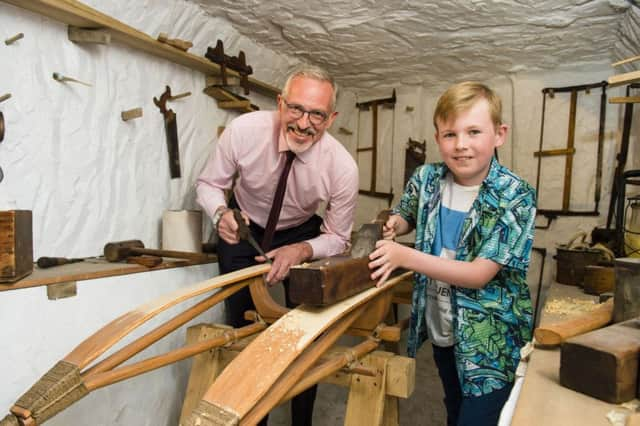Roamer: Two legends race against time and the elements for one goal - Antarctica


After losing the race to be first to the South Pole, Captain Scott’s 17-month expedition terminated tragically in a tiny tent, battered by a screeching, gale-forced wall of snow, on March 29, 1912.
The names of Scott’s fellow explorers who died in the final days of their unfinished return journey - Captain Oates and Lieutenant Evans - and the two who perished with him in the tent - Dr Edward Wilson and Lieutenant Bowers - are forever bound together with the name of Captain Robert Falcon Scott C.V.O., R.N.
Advertisement
Hide AdAdvertisement
Hide AdWilson, Bowers and Scott were just 12 miles from a life-saving supply-depot when they died.
Scott’s heroic team tackled the ultimate limits of human endurance and survival in the harshest weather conditions and most difficult terrain on earth.
We all know the story.
Many of us have seen the films and read the books, but a unique, world-class, exhibition in Titanic Belfast has brought Scott’s Antarctica onto our collective doorstep!
The interactive multi-media ‘Race to the End of the Earth’, described by the New York Times as ‘five-star’ and ‘engrossing’, follows in the fearless footsteps of Norwegian Roald Amundsen and Captain Scott as they compete with time, terrain, sub-zero temperatures…and each other.
Two legends with one goal - Antarctica!
Advertisement
Hide AdAdvertisement
Hide AdRunning until the end of August, the American Museum of Natural History’s exhibition - its first sojourn in the U.K and Ireland - amply confirms Titanic Belfast as a star on the international stage of world-class attractions.
The world’s top cultural institutions vied for Scott and Amundsen’s vividly recreated struggle for supremacy over the South Pole.
Titanic Belfast’s Andrews Gallery triumphed!
Two graphically illustrated time-lines, punctuated with full-size facsimiles, models and artefacts, follow the routes of the Norwegian and British teams from ship to shore, from base camp to store depot, across ice flow and ice shelf, through blizzards and snow drifts to the final, desolate, glacial plateau.
Lights and sound effects, sombre music, heart-breaking commentary and evocatively-flickering black and white film clips, all come together to turn the Andrews Gallery into an awesomely realistic and grippingly informative polar adventure.
Advertisement
Hide AdAdvertisement
Hide AdOutline introductions to both teams of explorers and descriptions of their very basic resources are packed with detail.
Scott’s 25-year-old, 187-foot wooden whaling ship Terra Nova, reeking of blubber, “rode frighteningly low in the water.”
Visitors perusing these unnerving specifications in a darkened corridor echoing with the rumble of breaking waves and howling winds aren’t much comforted to learn that the tiny barque’s bow was reinforced with seven-foot-thick oak beams!
Amundsen’s Fram, meaning ‘forward’, was a state-of-the-art vessel designed to sail through ice.
Advertisement
Hide AdAdvertisement
Hide AdThere were 18 Norwegian explorers and over 100 dogs on board, and an extra 19 puppies when they got to the Bay of Whales!
Scott arrived at Cape Evans with 64 men, 35 in the Royal Navy, 12 scientists, two paying volunteers, 31 dogs, 19 ponies and three experimental motorised vehicles.
Both ships anchored to the ice in Antarctica in January 1911, hundreds of miles apart.
One of Scott’s prototype snow tractors soon spluttered with fatal freeze-up!
Advertisement
Hide AdAdvertisement
Hide Ad“How did they keep warm? What were the unknowns? What birds did they see?” are some of the questions outlined on a circular information table, with answers behind the flip of a flap!
Despite their woollen ‘fearnaught’ (‘fear nothing’) anti-freeze clothing, first fashioned by Captain Cook, Scott’s men “were cold all the time”!
(The Norwegians took pride in their furs based on Inuit designs.)
Antarctica covered 5.5 million square miles; it was minus 128.6 degrees Fahrenheit and the average height above sea level was about 7,100 feet.
The most ubiquitous bird was the Adélie Penguin.
Advertisement
Hide AdAdvertisement
Hide AdBoth teams used sleeping bags made from reindeer skins but the British grumbled that theirs’ had been “badly selected and moult continually.”
The Norwegians hadn’t a team doctor, and their replica standard-issue medical kit, packed with knives and scalpels, is only slightly less reassuring than the British version containing vials and tubes of creams, ‘salves for the skin’, cocaine eye-drops, laxatives and something called ‘The Tortoise’ - a portable, emergency field-dressing “for immediate application to wounds.”
Until near the end of the ill-fated five’s hopeless struggle homewards, Dr Wilson was in sole charge of the opium and morphine.
Some of the exhibition’s intriguing highlights are full-scale, replica interiors at the base-camps, including Amundsen’s under-snow workshop, the British officers’ sleeping quarters and Captain Scott’s Cape Evans hut.
Advertisement
Hide AdAdvertisement
Hide AdAs the relentlessly upsetting time-line reveals progressive despair, Scott’s diary hints at tragedy.
On 24 February he writes “we are all on the verge of severe frostbite and though we constantly talk of fetching through, I don’t think one of us believes it in his heart.”
While Amundsen’s victorious team celebrated under Tasmanian sunshine, far away and badly frostbitten in their iced-up, snow-laden tent, slowly and painfully Scott penned his final journal entry.
“The end cannot be far. It seems a pity, but I do not think I can write more.”
Advertisement
Hide AdAdvertisement
Hide AdAccording to historian George Seaver, when they were found Wilson and Bowers lay dead “in the attitude of sleep, their sleeping bags closed over their heads. Scott lay between them, half out of his sleeping bag, propped against the tent lining, his left arm flung across Wilson.”
For full details about the exhibition visit www.titanicbelfast.com